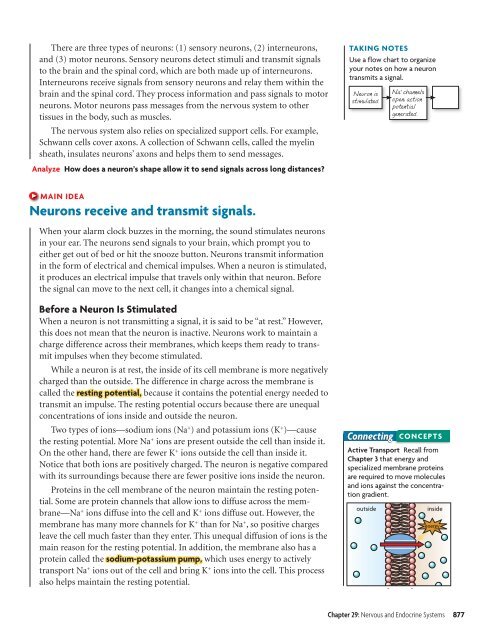You also want an ePaper? Increase the reach of your titles
YUMPU automatically turns print PDFs into web optimized ePapers that Google loves.
There are three types of neurons: (1) sensory neurons, (2) interneurons,<strong>and</strong> (3) motor neurons. Sensory neurons detect stimuli <strong>and</strong> transmit signalsto the brain <strong>and</strong> the spinal cord, which are both made up of interneurons.Interneurons receive signals from sensory neurons <strong>and</strong> relay them within thebrain <strong>and</strong> the spinal cord. They process information <strong>and</strong> pass signals to motorneurons. Motor neurons pass messages from the nervous system to othertissues in the body, such as muscles.The nervous system also relies on specialized support cells. For example,Schwann cells cover axons. A collection of Schwann cells, called the myelinsheath, insulates neurons’ axons <strong>and</strong> helps them to send messages.Analyze How does a neuron’s shape allow it to send signals across long distances?TAKING NOTESUse a flow chart to organizeyour notes on how a neurontransmits a signal.Neuron isstimulated.Na + channelsopen; actionpotentialgenerated.MAIN IDEANeurons receive <strong>and</strong> transmit signals.When your alarm clock buzzes in the morning, the sound stimulates neuronsin your ear. The neurons send signals to your brain, which prompt you toeither get out of bed or hit the snooze button. Neurons transmit informationin the form of electrical <strong>and</strong> chemical impulses. When a neuron is stimulated,it produces an electrical impulse that travels only within that neuron. Beforethe signal can move to the next cell, it changes into a chemical signal.Before a Neuron Is StimulatedWhen a neuron is not transmitting a signal, it is said to be “at rest.” However,this does not mean that the neuron is inactive. Neurons work to maintain acharge difference across their membranes, which keeps them ready to transmitimpulses when they become stimulated.While a neuron is at rest, the inside of its cell membrane is more negativelycharged than the outside. The difference in charge across the membrane iscalled the resting potential, because it contains the potential energy needed totransmit an impulse. The resting potential occurs because there are unequalconcentrations of ions inside <strong>and</strong> outside the neuron.Two types of ions—sodium ions (Na + ) <strong>and</strong> potassium ions (K + )—causethe resting potential. More Na + ions are present outside the cell than inside it.On the other h<strong>and</strong>, there are fewer K + ions outside the cell than inside it.Notice that both ions are positively charged. The neuron is negative comparedwith its surroundings because there are fewer positive ions inside the neuron.Proteins in the cell membrane of the neuron maintain the resting potential.Some are protein channels that allow ions to diffuse across the membrane—Na+ ions diffuse into the cell <strong>and</strong> K + ions diffuse out. However, themembrane has many more channels for K + than for Na + , so positive chargesleave the cell much faster than they enter. This unequal diffusion of ions is themain reason for the resting potential. In addition, the membrane also has aprotein called the sodium-potassium pump, which uses energy to activelytransport Na + ions out of the cell <strong>and</strong> bring K + ions into the cell. This processalso helps maintain the resting potential.ConnectingCONCEPTSActive Transport Recall fromChapter 3 that energy <strong>and</strong>specialized membrane proteinsare required to move molecules<strong>and</strong> ions against the concentrationgradient.outsideinsideenergyChapter 29: <strong>Nervous</strong> <strong>and</strong> <strong>Endocrine</strong> <strong>Systems</strong> 877
















